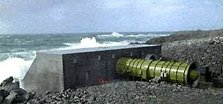In the UK, around 15% of the domestic electricity demand could be met by wave energy. Wave power is reliable, produces no greenhouse gases and reduces our dependence on fossil fuels. Wave power devices absorb energy from waves, converting it to electricity. On-shore generators usually consist of a partially submerged shell, where sea water is free to enter and leave as the waves travel.
As waves enter the shell chamber, the level of water rises, compressing the air in the top of the chamber, which is then forced through a blow-hole into the turbine to generates electricity. When the waves draw back, air returns under pressure into the chamber, keeping the turbine moving at all times. This constant stream of air in both directions produces enough movement in the turbine to drive a generator, which converts the energy into electricity.
|

